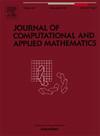Fractional-order supply chain finance system with conformable derivative: Chaotic dynamics, complexity analysis, and RGB color image encryption
IF 2.6
2区 数学
Q1 MATHEMATICS, APPLIED
Journal of Computational and Applied Mathematics
Pub Date : 2025-09-27
DOI:10.1016/j.cam.2025.117105
引用次数: 0
Abstract
Based on the supply chain management rules, a new 4D conformable fractional-order supply chain finance system is discussed. The numerical solution of the proposed system is obtained by adopting the conformable Adomian decomposition method (CADM). Some basic dynamical characteristics are employed either numerically or analytically to demonstrate the chaotic dynamical behaviors of the new system, including equilibrium points and their stability, Lyapunov exponents spectrum, fractal dimension, bifurcation diagrams, and complexity analysis. The fractional calculus theory and computer simulations reveal that the system’s lowest order to yield chaos is 0.461. Bifurcation diagrams, phase plots, and a multiscale spectral entropy (MSE) complexity analysis validate the results. Additionally, chaos synchronization of the novel conformable fractional-order chaotic system is achieved by designing a suitable nonlinear controller, based on the stability theory of fractional-order dynamical systems. Furthermore, this paper constructs a new scheme for encrypting color images based on chaos synchronization to enhance practicality. Experiments and computer simulations are conducted to verify the performance and security of the proposed image cryptosystem.
具有相容导数的分数阶供应链金融系统:混沌动力学、复杂性分析和RGB彩色图像加密
基于供应链管理规则,讨论了一种新的四维合规化分数阶供应链金融体系。采用仿形Adomian分解法(CADM)得到了该系统的数值解。采用数值或解析的方法对新系统的混沌动力学行为进行了分析,包括平衡点及其稳定性、李雅普诺夫指数谱、分形维数、分岔图和复杂度分析。分数阶微积分理论和计算机模拟表明,该系统产生混沌的最低阶数为0.461。分岔图,相位图和多尺度谱熵(MSE)复杂性分析验证了结果。此外,基于分数阶动力系统的稳定性理论,通过设计合适的非线性控制器,实现了新型符合分数阶混沌系统的混沌同步。在此基础上,提出了一种新的基于混沌同步的彩色图像加密方案,提高了加密方案的实用性。实验和计算机模拟验证了所提出的图像密码系统的性能和安全性。
本文章由计算机程序翻译,如有差异,请以英文原文为准。
求助全文
约1分钟内获得全文
求助全文
来源期刊
CiteScore
5.40
自引率
4.20%
发文量
437
审稿时长
3.0 months
期刊介绍:
The Journal of Computational and Applied Mathematics publishes original papers of high scientific value in all areas of computational and applied mathematics. The main interest of the Journal is in papers that describe and analyze new computational techniques for solving scientific or engineering problems. Also the improved analysis, including the effectiveness and applicability, of existing methods and algorithms is of importance. The computational efficiency (e.g. the convergence, stability, accuracy, ...) should be proved and illustrated by nontrivial numerical examples. Papers describing only variants of existing methods, without adding significant new computational properties are not of interest.
The audience consists of: applied mathematicians, numerical analysts, computational scientists and engineers.

 求助内容:
求助内容: 应助结果提醒方式:
应助结果提醒方式:


